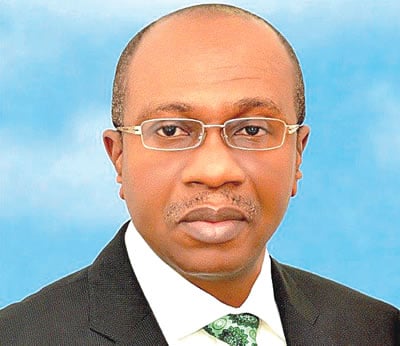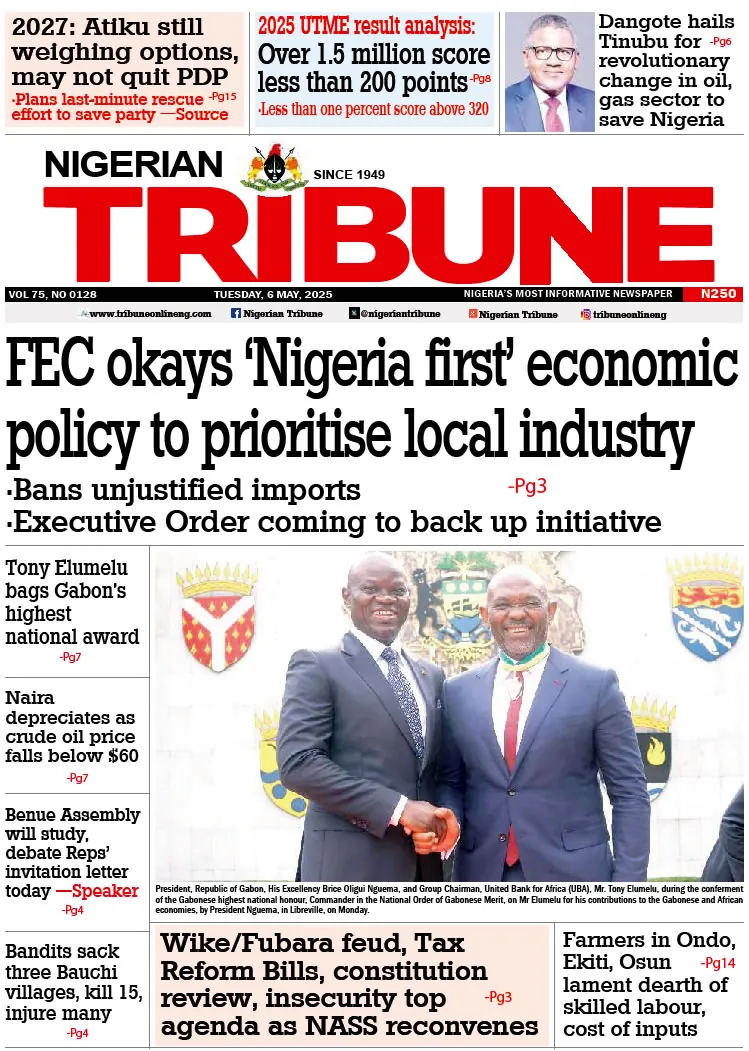
THE administration of the Central Bank of Nigeria ( CBN), is carried out by the governor and four deputy governors of the lender.
There have been series of amendments to the Act establishing CBN since 1958. These amendments are aimed at keeping it in tandem with evolving financial landscape. At present, the bank is adjudged on the 2007 act.
The act stipulates that decisions that go beyond administrative activity of the bank but bore on policy choice should be determined by the Monetary Policy Committee (MPC).
WHAT DOES MPC DO?
The monetary policy committee (MPC) is the highest policy making committee of the CBN mandated to: Review economic and financial conditions in the economy; determine appropriate stance of policy in the short to medium term; review regularly, the CBN monetary policy framework and adopt changes when necessary; communicate monetary/financial policy decisions effectively to the public and ensure the credibility of the model of transmission mechanism of monetary policy.
Overall, the MPC’s objective is to maintain price stability and support the economic policies of the Federal Government by formulating monetary and credit policies.
QUORUM ISSUES
However, the all-important MPC meeting scheduled to hold January 22 to 23, 2018 will not be able to hold because of quorum issues.There are currently only five members of the committee available — whereas the quorum is six out of 12 members, as defined by the second schedule of the CBN Act.
At the same time the act states that the board must meet a maximum of 6 times and minimum of 4 times in a year. Thus, the meeting schedule for the year 2018 is as follows: 22-23 January,2018;19-20 March, 2018;20-21 May, 2018; 23-24 July, 2018 ;24-25 September, 2018 and 20-21 November, 2018.
In recent times the board has experienced depletion due to most members reaching their retirement age and other related issues.
The MPC, according to information on the website of the CBN, shall comprise the governor of the Bank who shall be the chairman; the four deputy governors of the Bank; two members of the board of directors of the Bank; three members appointed by the president; and two members appointed by the governor.
On Tuesday last week, Suleiman Barau retired as CBN deputy governor (operations), and there are feelers that another deputy governor, Adebayo Adelabu (corporate services), has served notice of disengagement ahead of the 2019 governorship election in Oyo state.
Sarah Alade, who was deputy governor for economic policy, had earlier retired in March 2017, but her replacement — Aishah Ahmad — is yet to be confirmed by the senate since her nomination in October 2017. All these are making it legally impossible for the MPC to meet.
Five external members of the committee ended their tenures in November 2017 and their replacements are yet to be confirmed by the senate.
PENDING CONFIRMATIONS
In April, Buhari announced the appointment of Ummu Ahmed Jalingo, Justitia Odinakachukwu Nnabuko, Mike I. Obadan, Abdu Abubakar and Adeola Adetunji as non-executive directors of the CBN board.
In October, he nominated Adeola Festus Adenikinju, Aliyu Rafindadi Sanusi, Robert Chikwendu Asogwa and Asheikh A. Maidugu as new members of the MPC, subject to senate confirmation.
But the senate refused to screen Buhari’s nominees in line with its July 4 resolution to suspend all executive confirmation requests until Ibrahim Magu is removed as the acting chairman of the Economic and Financial Crimes Commission (EFCC).
The senate had refused to confirm Magu because of allegations of corruption, but Buhari has kept him in an acting position for the past two years.
The senate is demanding that Magu be replaced before it would continue to confirm presidential nominations.
5-YEAR TREND OF JANUARY MPC DECISIONS
At the end of every meeting, the MPC will announce its decision on Monetary Policy Rate (MPR), Cash Reserve Ratio (CRR) Liquidity Ratio and Asymmetric Corridor of interest rate.
In an interview with Bloomberg in Abuja, Emefiele said: “I don’t think the interest rates will change; does economic data portend any significant changes in the policy rates? We don’t see that. Normally, when you begin the year, what you find is that you want to hold the policy rate steady.”
In line with the governor’s submission, Nigeria Tribune checks showed that for the past five years, the MPC had always kept existing benchmark interest rate unchanged in its January meetings. Other policy decisions also followed the same trend from January 2013 to January 2017, except in 2014, when the public sector CRR was adjusted, not MPR.
For instance, it retained a 14 per cent Monetary Policy Rate at the end of its first meeting for 2017.The liquidity ratio and the Cash Reserve Ratio (CRR) were also unchanged. While the liquidity ratio remained 30per cent, the CRR was left at 22.50per cent. It also retained the asymmetric corridor at +200 and -500 basis points around the MPR.Ten out of 11 members of the committee were present at the meeting.
Similarly, the Monetary Policy Committee met on 25th and 26th January, 2016 against the backdrop of weakening global economic prospects as well as increased risks in the domestic economic environment. In summary, the MPC voted to retain: the CRR at 20.0 per cent; MPR at 11.0 per cent;Liquidity Ratio at 30 per cent; The asymmetric corridor at +200 basis points and -700 basis points.
Central Bank of Nigeria Communique No. 99 of the Monetary Policy Committee Meeting of Monday 19th and Tuesday 20th January, 2015 showed that all eleven members voted to retain the MPR at 13 per cent; retain the CRR on Private Sector deposits at 20 per cent; retain CRR on Public Sector deposits at 75 per cent; and retain the liquidity ratio at 30 per cent. .
The Central Bank of Nigeria Communiqué No. 93 of the Monetary Policy Committee Meeting of Monday 20 and Tuesday 21 January, 2014, had the following decision: “MPR remains at 12 per cent +/- 200 basis points and liquidity ratio (LR) at 30 per cent. “Public sector CRR increased from 50 per cent to 75 per cent. Private sector CRR retained at 12 per cent. The CBN to take immediate step to redress the supply-demand imbalance in the BDC segment while maintaining its focus on anti-money laundering (AML) activities.”
The Monetary Policy Committee (MPC) met on, January 21, 2013 with ten (10) out of the twelve (12) members in attendance.
In a communiqué No. 87 of the Monetary Policy Committee Meeting of Monday, January 21, 2013, members therefore, decided by a majority vote of 8:2 to maintain the policy stance i.e., to retain the MPR at 12.0 per cent with a corridor of +/- 200 basis points around the midpoint; retain the CRR at 12.0 per cent; and to retain the Liquidity Ratio at 30.0 per cent. Two members voted for a reduction of the MPR by 25 basis points.
IMPLICATIONS FOR THE ECONOMY
If the senate had done the needful, the new members would have quickly settle down to work, given the desperation for policy response to reduce implementation lags. Moreover, the bank will have to provide needed guidance to the market ranging from goal objective to numerical target, which should have been done in the first meeting.
But expert opinion is that the inability of the MPC to sit and provide direction for the economy will have little or no effect. According to a herd of experts, monetary policy implementation is supposed to work in tandem with fiscal policy, but where the budget is yet to be passed, not much is expected to be done from the monetary space. Given that the 2017 Budget was only finalised in July, there is no guarantee that this year’s budget will be finalised earlier.
They posited that the pathway to lower interest rate was to ensure monetary and fiscal authorities’ collaboration with the private sector.
Omotola Abimbola, a research and investment analyst at Afrinvest (West) Africa Limited sees this as rather unfortunate, but believes that it will have no significant negative impact on the economy.
According to him, the MPC meeting would have given investors and analysts the opportunity to know the monetary policy direction in the new year.
However, he said that failure to hold the MPC meeting as scheduled, will have little or no effect on the market and economy in general because in the last 2 years, CBN policy tools being deliberated upon have not really been instrumental to the direction of the market.
“Rather, the central bank has been using open market operation and market clearing rates at the OMO auctions as the main instruments to guide direction of the market. So, what investors will look at is the frequency of the mop-ups to get direction,” Abimbola said.
For the foreign investors, he regretted that the situation portends reputational damage as it is a wrong signal about uncertainty in policy direction. He added that this is another way of allowing politics to interfere with monetary policy.
Also, in his earlier reaction, Chief Executive Officer, Financial Derivatives Company Limited, Mr Bismarck Rewane, said there was no need for panic.
His words: “In any case, what does the MPC do? Most of the changes in policy instruments have taken place outside the MPC meeting. So, the MPC has become a ritual. So, there is no need to panic.”
Conclusively, there are expectations that before the next scheduled MPC meeting, the upper chamber would have screened the presidential nominees, and the committee will likely form a quorum. Monetary policy stance in 2018 could change when the underlying fundamentals become supportive. If the pace of decreasing inflation becomes adequate and inflation is seen at predicted levels, the MPC may begin to see strong justification for an easing of monetary policy, which may further accelerate Nigeria’s economic recovery process.
But Emefiele made it clear that: “We must not be quick to discard the restrictive measures which aided our recovery simply because the metrics have improved.” This to some analysts, is a clear indication that the Monetary Policy Committee will continue to maintain its current restrictive measures.




